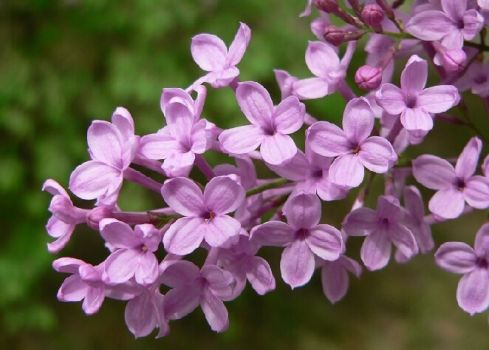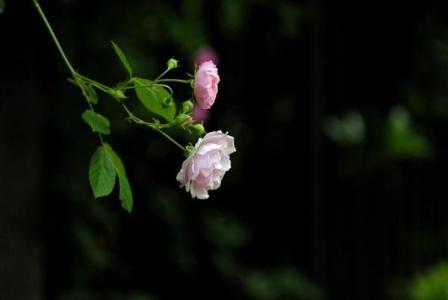The planting method of rose flower
The first method-cutting planting
Cutting method is the most common planting method, which is generally carried out in late spring and early summer. First of all, we should select suitable branches, generally choose branches that are well-growing, well-developed and free of insect pests and diseases, cut them off, dry them for two days, wait for the wound to heal, insert them into the soil, and then keep the soil moist. Just wait for it to take root.
The second method-sowing and planting
Sowing is also a way of reproduction, first of all, to collect the seeds of roses, and then dry the seeds, wait until the seeds dry before the seeds can be planted in the soil. Then make sure the soil is moist and nutritious, and finally wait for it to take root and sprout.
When will the roses be planted? Brief introduction of planting methods and cultivation techniques of Rose
Rose is one of the most famous ornamental plants in the world, and it has a long history of cultivation in China. After the introduction of rose in China in the 18th and 19th century, it crossed and backcrossed with the original varieties, and cultivated rose, perfume rose, wild rose and rose and other varieties. It has a very high ornamental value. Let's take a look at when the roses will be planted.
When will the roses be planted?
The rose can be planted all the year round, keeping the root system moist in the growing season and preventing cold in winter, but it is suitable from autumn defoliation to spring sprouting, and the best planting period is from autumn defoliation to freezing. In order to make the plant grow and enlarge the flower cluster as soon as possible, large holes must be planted with 1 meter long and 1 meter wide, 0.6-0.8 meters deep, or digging planting ditches with 0.6-0.8 meters deep and 0.8 meters wide. Plant application of organic fertilizer, calcium superphosphate, mixed with the soil and concentrated application in the soil depth of 0.2 to 0.5 meters, after planting, timely irrigation.
The Propagation method of Rose
Rose seed can be used for raising seedlings, but it is easy to survive by using tender wood cuttings in the same year in production. Valuable varieties are difficult to cut and can be propagated by pressing or grafting. Seedlings of asexual reproduction can blossom in the same year. For the seedlings used as potted flowers, the older branches of fine varieties should be selected, the seedlings should be raised by striping method, and attention should be paid to pruning the main buds and artificial dwarfing. For seedlings used as cut flowers, varieties that can form mother branches and colorful flowers should be selected to raise seedlings. Rose can also be propagated by tissue culture, water culture, ramet and other methods.
The planting method of rose flower
1. Soil: the rose flower is not strict in soil, resistant to drought and barren. It is most suitable to grow in deep, loose, fertile, moist and well-drained soil, and it can also grow normally in clayey soil. Whether planted in the ground or potted, the cultivation soil of rose flowers should be fully mature sandy soil as the best.
2. Illumination: the rose is a light-loving flower, which likes plenty of sunshine, and it is also resistant to semi-shade, cold and adaptability. it is suitable to be planted in all parts of the south except for the severe cold in winter. Roses should have enough sunshine during their growth so that they can flourish and blossom more.
3. Watering: roses like to be wet, afraid of being wet and avoid waterlogging. From the rose sprouting to blooming, you can properly irrigate some more water, with the soil moist but without stagnant water as the best. After the rose blossoms, you should reduce the amount of water, dry and wet the soil when watering, and pay attention to drainage and waterlogging in the rainy season to avoid stagnant water rotting the roots.
4. Fertilization: roses prefer fertilizer and are resistant to barren. Liquid fertilizer dominated by nitrogen can be applied once or twice in March to promote the branches and leaves of roses to flourish. In April and May, fertilizers mainly based on phosphorus and potassium can be applied 2 to 3 times. In order to promote the rose flower to have more pregnant buds and blossom, and then apply rehabilitation fertilizer again after flowering, then you can stop fertilization. Roses need to cultivate soil and fertilize once a year in winter.
5. Pruning: pruning and shaping is an indispensable process in most flower breeding, and natural roses are no exception, especially when cultivated as potted flowers, we should pay more attention to pruning and shaping. In general, adult roses are pruned before germination every spring, and the amount should be moderate to ensure that the branches of the roses are dense and beautiful. The old branches and dense branches of roses should be often trimmed every winter to maintain good light transmission and ventilation so as to reduce diseases and insect pests.
Matters needing attention in the cultivation of Roses methods of propagation of roses
Rose is one of the world-famous ornamental plants, and it has a long history of cultivation in China. As far back as 1630 when Wang Xiang Jin wrote "Qunfang Spectrum", Chen Yuanzi wrote "Secret Flower Mirror" in 1688, and Wang Hao wrote "Guang Qun Fang Spectrum" in 1708, there have been records of roses, roses, roses and woody flowers. let's take a look at the rose culture methods and matters needing attention.
Propagation method of rose flower
Rose seed can be used for raising seedlings, but it is easy to survive by using tender wood cuttings in the same year in production. Valuable varieties are difficult to cut and can be propagated by pressing or grafting. Seedlings of asexual reproduction can blossom in the same year. For the seedlings used as potted flowers, the older branches of fine varieties should be selected, the seedlings should be raised by striping method, and attention should be paid to pruning the main buds and artificial dwarfing. For seedlings used as cut flowers, varieties that can form mother branches and colorful flowers should be selected to raise seedlings. Roses can also be propagated by tissue culture, water culture, grafting, plantlet and so on.
Matters needing attention of rose flowers
1. Anthracnose of rose flower
[symptoms] the plaque occurs at the edge of the leaf, semicircular, dark brown at the edge, brown to light brown in the middle, and small black spots on the plaque in the later stage. The pathogen overwintered on the diseased leaves. Under warm and humid conditions, spore germination invades leaves. The plant cluster is too dense and the moisture retention time is long, so it is easy to develop the disease. Anthracnose occurs sporadically and can be treated simultaneously in the prevention and treatment of black spot and leaf spot.
[prevention and control] clear the garden in time in late autumn and early winter, collect diseased fallen leaves and burn them. Strengthen maintenance, proper pruning, thinning too dense branches, so as to make good ventilation and light transmission. Spray 20% Longke bacteria (thiobacillus copper) suspension 500 times or 78% Cobo (wave) if necessary. Manganese and zinc) wettable powder 600x liquid, 75% Dakonine (chlorothalonil) wettable powder 600x liquid, 50% Shibaogong or Shibake (prochloraz) wettable powder 1000 times liquid, 25% carbon tetralin wettable powder 500x liquid.
2. Rose powdery mildew
[symptoms] the disease can occur in leaves, petioles, shoots and buds. There are irregular powdery mildew spots on the adult leaves, and the diseased leaves gradually turn brown from the tip or edge of the leaves, resulting in the drying and shedding of the whole leaves. Young leaves infected, chlorosis spread, gradually expanded, the edge is not obvious, young leaves on both sides of the white powder spots, and then covered with the whole leaf, the leaves become light gray or purplish red. The new leaves are wrinkled and deformed. After infected with petiole and new shoot, the internodes were shortened, the stem became thinner, some of the diseased shoots were withered, and the diseased part was also covered with white powder. The bud is infected, the bud and pedicel are covered with white powder, the calyx, petals and pedicels are deformed, and the serious ones wither and die, losing their ornamental value. Powdery mildew overwinters on diseased buds. Planting is too dense, nitrogen application is too much, poor ventilation, lack of sunlight, easy to develop.
[control] varieties resistant to powdery mildew were selected. When pruning in winter, pay attention to cutting off diseased branches and buds. The disease resistance was improved by applying less nitrogen fertilizer and more phosphorus and potassium fertilizer during the disease onset period. Pay attention to ventilation and light, timely drainage after rain, to prevent moisture retention, can reduce the incidence of disease. At the initial stage of the disease, 20% triadimefon EC 1000 times or 20% triadimefon sulfur suspension 1000 times and carbendazim wettable powder 1000 times were sprayed. If there is resistance to the above fungicides, 12.5% nitrilazole EC or 3000 times Teflin wettable powder can be sprayed instead. Spray Baume 2 / 3 stone sulfur mixture or 45% crystal stone sulfur mixture 40 / 50 times before sprouting in early spring to kill overwintering bacteria.
3. Roseflower beetle
[characteristics] Rose beetles mainly damage roots, leaves, buds and other parts, which seriously affect the yield and quality of flowers.
[prevention and control] Light trapping, willow trapping, oscillating trapping, etc. When the damage is serious, 2.5% deltamethrin 2000-3000 times or 50% phoxim 1000-1500 times can be sprayed. The effect is good, but it must not be sprayed at flowering stage.
- Prev

Propagation methods of lilac flowers:
1. Cutting method We select robust branches with cloves growing for 1 ~ 2 years for cutting. usually we cuttage time is 1 month after blooming in spring, 15 to 20cm branches are selected, branches with buds are selected, 2 to 3 pairs of bud nodes are best, one pair of bud nodes is buried in the soil.
- Next

The mode of propagation of rose flowers
First, sowing is also a way of reproduction. First, collect the seeds of the rose, then dry the seeds, and wait until the seeds are dry before planting the seeds in the soil. Then make sure the soil is moist and nutritious, and finally wait for it to take root and sprout.
Related
- Fuxing push coffee new agricultural production and marketing class: lack of small-scale processing plants
- Jujube rice field leisure farm deep ploughing Yilan for five years to create a space for organic food and play
- Nongyu Farm-A trial of organic papaya for brave women with advanced technology
- Four points for attention in the prevention and control of diseases and insect pests of edible fungi
- How to add nutrient solution to Edible Fungi
- Is there any good way to control edible fungus mites?
- Open Inoculation Technology of Edible Fungi
- Is there any clever way to use fertilizer for edible fungus in winter?
- What agents are used to kill the pathogens of edible fungi in the mushroom shed?
- Rapid drying of Edible Fungi

